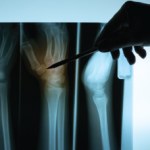Notable in the study, however, is the low rates of screening for women aged 65 and older. The study found that fewer than one in four women in this age group underwent screening for primary prevention during a two-year period, says Dr. Gillespie.
When looking at screening rates by race, the study found disparities: Non-Hispanic black women were the least likely to be screened, and Hispanic women and Asian women the most likely to undergo screening. Dr. Gillespie emphasizes, however, that over time, these disparities narrowed substantially. “For example, the disparity in adjusted screened probabilities comparing white and black women was reduced by 66% among women aged 50–64 and was virtually eliminated among women age 65+,” she says.
Underutilization of Services Following Hip Fracture
In the study looking at screening rates between 2008 and 2014 in women following a first hip fracture, Dr. Gillespie and Ms. Morin also found low utilization rates, with only 9.9% of women receiving bone mass measurement within six months of fracture and 12.7% within 12 months of fracture.3
When looking at specific age groups, women 80 years and older were significantly less likely to utilize recommended osteoporosis screening and treatment services within six months of their fracture compared with women aged 50–79 years old (13.8% vs. 20.8%, P<0.001). Overall, the study found that the use of pharmacotherapy in this age group declined over the study period.
For women aged 65 and older, the study found a significant increase in osteoporosis screening over the study period, but a decline in use of pharmacotherapy to treat osteoporosis.
For women aged 50–64 years, osteoporosis screening declined over the study period, but the use of pharmacotherapy remained steady.
Overall, Dr. Gillespie and Ms. Morin emphasize that the study highlights that only one in five women receives the recommended osteoporosis care in a timely manner and find this “alarming.”
Why the Persistently Low Rates?
Karen Hansen, MD, MS, associate professor, Division of Rheumatology and Endocrinology, University of Wisconsin Health, Madison, Wis., offered a number of potential explanations for the low utilization of osteoporosis screening. Among these, she says, is the misperception of the lack of safety of the drugs used to treat osteoporosis. Another is the continual gradual reduction in Medicare reimbursement for bone density tests that has resulted in fewer clinics offering them. For older patients, she highlights the thinking by many patients that fractures are simply a part of the aging process and are to be expected. In addition, when compared with the other multiple health problems many older patients face, such as heart and lung disease, bone health doesn’t rank as a priority in many of these patients.

